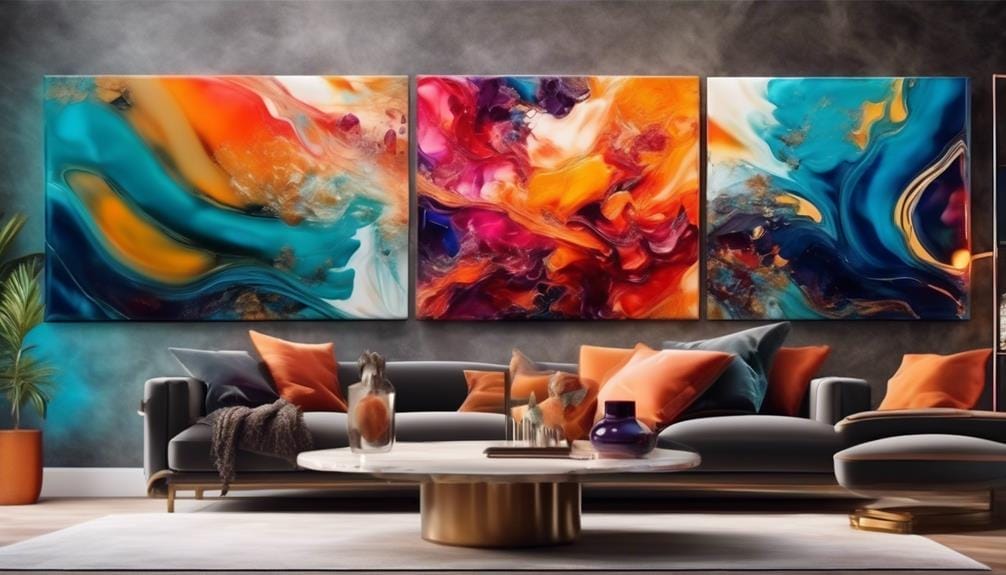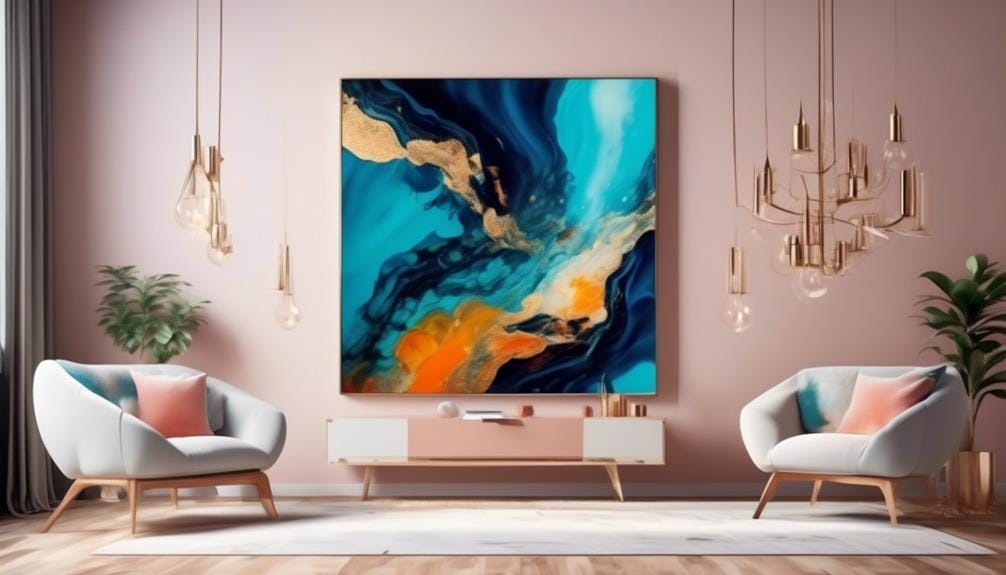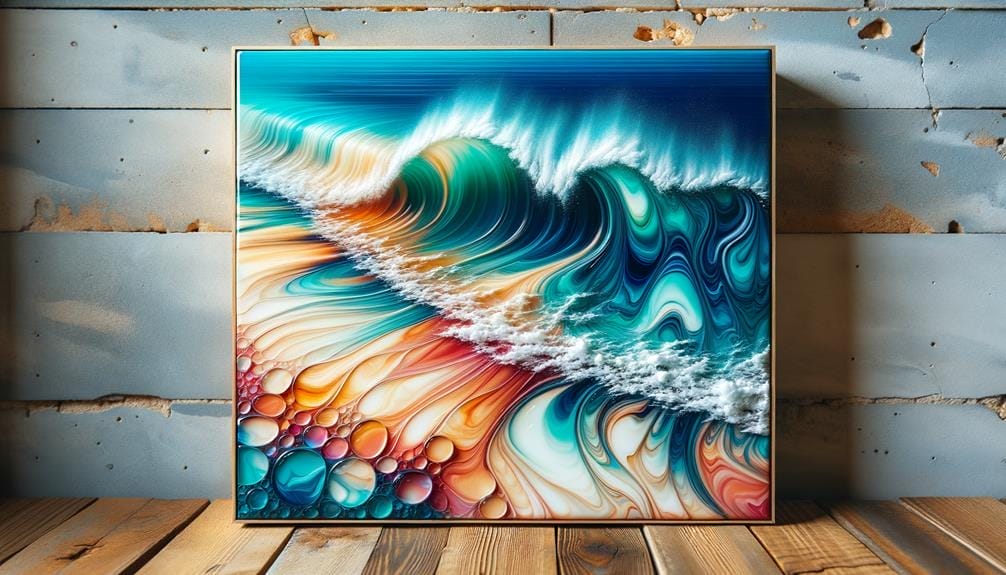Table of Contents
Add a header to begin generating the table of contents
Like a clear, protective shield that wraps around your artistic creations, epoxy resin has become a go-to medium for artists seeking a glossy and durable finish. But its uses go far beyond mere protection.
With epoxy resin, you can add depth and dimension to your artwork, enhance colors and textures, and even preserve and protect your precious creations.
In this discussion, we will explore the many advantages of epoxy resin in art, learn techniques for applying it to artwork, and troubleshoot common issues that may arise along the way.
Get ready to uncover the endless possibilities that epoxy resin holds for your art projects.
Key Takeaways
- Epoxy resin is a versatile material that offers artists more control and durability in their artwork.
- There are various techniques for applying epoxy resin, such as brushing, pouring, spraying, layering, and tipping.
- Epoxy resin enhances colors and textures in art and jewelry projects, providing a clear and glossy finish.
- It is important to prioritize safety, proper mixing techniques, and troubleshooting common issues to achieve the desired results with epoxy resin.
Advantages of Epoxy Resin in Art
Epoxy resin offers numerous advantages in the world of art, making it a popular choice among artists and crafters alike.
One of the main advantages of using epoxy resin, such as clear epoxy resin or art resin, is its ease of use. It's a material that's easy to work with, allowing artists to have more control over their creations. Whether you're coating a surface or embedding objects in resin, epoxy resin provides a smooth and even finish.
Another advantage of epoxy resin is its long-lasting properties. Once cured, epoxy resin becomes incredibly durable, ensuring that your artwork or jewelry pieces will stand the test of time. This longevity is essential for art projects and jewelry, as it ensures that the pieces will maintain their beauty and integrity even after years of use.
Furthermore, epoxy resin is compatible with a wide range of pigments, allowing artists to create vibrant and unique designs. Whether you're using epoxy resin for resin art or for coating jewelry pieces, the versatility of this material allows for endless possibilities in terms of color and design.
Techniques for Applying Epoxy Resin on Artwork
To achieve a smooth and professional finish on your artwork, various techniques can be employed when applying epoxy resin. These techniques are essential for ensuring that the resin is evenly distributed and properly adheres to the surface of your artwork. By following these techniques, you can enhance the overall appearance of your art and protect it from damage.
| Techniques for Applying Epoxy Resin on Artwork | Explanation |
|---|---|
| Brushing | Using a brush, apply epoxy resin in even strokes for a smooth finish. This technique is ideal for smaller artworks. |
| Pouring | Pour epoxy resin onto the artwork, spreading it evenly with a spreader or brush. This technique is suitable for larger artworks. |
| Spraying | Use a spray gun to evenly coat the artwork with epoxy resin. This technique allows for a more controlled application, especially for intricate designs. |
| Layering | Apply multiple layers of epoxy resin, allowing each layer to cure before adding the next. This technique adds depth and dimension to your artwork. |
| Tipping | After applying epoxy resin, use a heat gun or blowtorch to remove any air bubbles. Tipping the artwork gently helps in spreading the resin evenly. |
Enhancing Colors and Textures With Epoxy Resin

Enhancing the colors and textures of your artwork can be achieved through the skillful application of epoxy resin.
Epoxy resin is a versatile material that provides a clear and glossy finish to art and jewelry projects. With a wide range of pigments available, you can create vibrant and customizable colors, adding a unique touch to your resin creations. Different types of epoxy resin, such as casting resins and deep pour resins, cater to various applications like filling molds, creating wood river tables, and coating surfaces for art projects.
When working with epoxy resin, it's essential to prioritize safety and proper mixing techniques to ensure optimal results. By carefully following the instructions, you can avoid introducing bubbles into the resin, which can affect the final appearance of your artwork. Epoxy resin can be used to create a variety of art and craft projects, including resin jewelry, coasters, tumblers, and artwork. Its ability to enhance colors and textures not only adds beauty but also increases the durability of your creations.
With epoxy resin, you have the power to transform your artwork into visually stunning pieces that stand out. Its glossy finish and vibrant colors bring life to your creations, making them truly captivating. Experiment with different techniques and pigments to create unique effects and textures, and watch your artwork come to life with the enhancing power of epoxy resin.
Creating Depth and Dimension With Epoxy Resin
Achieving a sense of depth and dimension in your artwork can be effectively accomplished through the strategic application of epoxy resin. By using clear resin in your epoxy art, you can create stunning visual effects that add a three-dimensional quality to your work. The transparent nature of epoxy resin allows light to pass through, enhancing the perception of depth and creating an illusion of space.
To emphasize the importance of creating depth and dimension in your artwork, consider the following table:
| Techniques for Creating Depth and Dimension |
|---|
| Layering different colors and textures |
| Embedding objects or elements |
| Utilizing varying levels of resin thickness |
Layering different colors and textures is a key technique for creating depth and dimension with epoxy resin. By applying multiple layers of resin, you can build up the colors and textures, creating a sense of depth. Embedding objects or elements within the resin adds another layer of dimension, as they appear to be floating or suspended in the artwork. Additionally, varying the thickness of the resin in different areas can create a sense of perspective and depth.
Preserving and Protecting Artwork With Epoxy Resin

By applying epoxy resin to your artwork, you can preserve and protect it with a clear and glossy finish, ensuring its longevity and safeguarding it from environmental factors and wear. Craft epoxy is a versatile material that can be used for various applications, including protecting your artwork.
Here are three reasons why using epoxy resin is an excellent choice for preserving and protecting your artwork:
- Super Clear Finish: Epoxy resin provides a crystal-clear finish, enhancing the colors and details of your artwork. It creates a smooth, glossy surface that adds depth and vibrancy to your piece.
- Resistance to Environmental Factors: Epoxy resin acts as a protective barrier, shielding your artwork from harmful UV rays, dust, moisture, and other environmental factors. This makes it ideal for preserving delicate and sensitive materials such as paintings, photographs, and mixed media pieces.
- Durability and Wear Resistance: Epoxy resin is highly durable and resistant to scratches, abrasions, and impact. It forms a sturdy protective layer that safeguards your artwork from everyday wear and tear, ensuring its longevity and preserving its original beauty.
Incorporating epoxy resin into your artwork not only enhances its visual appeal but also guarantees its long-term preservation. Whether you're a professional artist or a hobbyist, using epoxy resin can help protect your creations and ensure they stand the test of time.
Troubleshooting Common Issues With Epoxy Resin Art
To troubleshoot common issues encountered when working with epoxy resin art, it is important to address potential problems and find effective solutions. Here are some common issues that artists may encounter when working with epoxy resin and possible solutions to resolve them:
| Common Issues | Solutions |
|---|---|
| Bubbles in resin crafts | Use a heat gun or torch to remove bubbles and achieve a smooth finish. Apply heat in a sweeping motion to prevent overheating. |
| Objects rising to the top of the resin | Pour the resin in layers, allowing each layer to partially cure before adding more. This will help prevent objects from sinking or rising to the top. |
| Poor curing and weak bond | Thoroughly mix the resin and hardener to ensure proper curing and achieve a strong bond. Follow the manufacturer's instructions for the correct mixing ratio and technique. |
| Strong odor in resin projects | Work in a well-ventilated area to minimize the odor. Consider using a respirator mask for added protection. |
| Bubbles forming on wood surfaces | Seal the wood before applying epoxy resin to minimize the risk of bubbles forming. This can be done by applying a thin layer of sealant or primer to the wood surface. |
Frequently Asked Questions
Which Epoxy Resin Is Used for Art?
You should use clear epoxy resin for art projects. It offers a glossy finish and durability. However, colored resin can add vibrancy to your creations. Make sure to follow safety precautions and experiment with different techniques for unique effects.
What Is the Difference Between Artresin and Epoxy Resin?
Artresin and epoxy resin have differences when used for art. Artresin offers superior finish and clarity, but it may be pricier. Epoxy resin is a more general term and can be used for various projects. Consider your specific needs and preferences.
What Resin Do You Use for Resin Art?
When it comes to resin art, the best epoxy brands offer a range of options. To choose the right resin for your project, consider the desired techniques, common mistakes, and the specific needs of your art.
What Is the Best Epoxy to Use for Crafts?
The best epoxy for crafts is clear epoxy resin. It provides a glossy finish, durability, and versatility for various materials. Compared to acrylic resin, epoxy has better performance in art projects. Achieve a flawless result by properly mixing and pouring resin, and enhance your art with vibrant color pigments.
Conclusion
In conclusion, epoxy resin is a game-changer in the world of art. Its versatility and durability make it the perfect medium for creating unique and stunning artwork.
With its ability to enhance colors, create depth and dimension, and preserve and protect artwork, epoxy resin allows artists to bring their creative visions to life.
So whether you're a beginner or an experienced artist, incorporating epoxy resin into your art projects will take your work to the next level.
Share on facebook
Share on twitter
Share on linkedin
Share on pinterest
Share on reddit
Share on email





